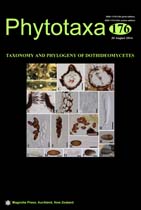Abstract
Didymosphaeriaceae is a ubiquitous fungal family that is reported to include saprobic, endophytic and pathogenic species associated with a wide variety of substrates. The family is characterized by 1-septate ascospores and trabeculate pseudoparaphyses, mainly anastomosing above the asci. In recent treatments Appendispora, Didymosphaeria, Roussoella, Phaeodothis and Verruculina were placed in the family. The aim of the present study is to delineate phylogenetic lineages within Didymosphaeriaceae and allied genera. A new species, Didymosphaeria rubi-ulmifolii, was isolated and identified based on morphological characters and phylogenetic analyses of partial 18S nrDNA and 28S nrDNA nucleotide sequence data. Didymosphaeria rubi-ulmifolii clustered with Montagnulaceae as a separate genus, while two putative strains (HKUCC 5834 and CMW 22186) of D. futilis from GenBank clustered with Cucurbitariaceae and Didymellaceae, respectively. The new species is characterized by immersed to slightly erumpent ascomata immersed under a clypeus, a peridium with compressed cells of textura intricata, long trabeculate pseudoparaphyses, anastomosing mostly above the asci and brown, 1-septate ascospores with granulate ornamentation. Phylogenetic analysis in combination with morphology and a review of literature show that Appendispora, Phaeodothis, Roussoella and Verruculina should be excluded from the family. Phaeodothis belongs in Montagnulaceae, Verruculina in Testudinaceae, while Appendispora and Roussoella belong in Roussoellaceae. The position of Didymosphaeriaceae as a distinct family, based on 1-septate ascospores and trabeculate pseudoparaphyses, mainly anastomosing above the asci is doubtful. Fresh collections of more Didymosphaeria strains are needed for epitypification and to obtain sequence data to establish if this family can be maintained.

